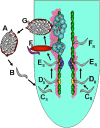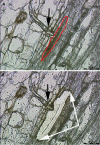Emerging approaches to broaden resistance of soybean to soybean cyst nematode as supported by gene expression studies
- PMID: 19675146
- PMCID: PMC2773110
- DOI: 10.1104/pp.109.144006
Emerging approaches to broaden resistance of soybean to soybean cyst nematode as supported by gene expression studies
Figures


Similar articles
-
Arabidopsis genes, AtNPR1, AtTGA2 and AtPR-5, confer partial resistance to soybean cyst nematode (Heterodera glycines) when overexpressed in transgenic soybean roots.BMC Plant Biol. 2014 Apr 16;14:96. doi: 10.1186/1471-2229-14-96. BMC Plant Biol. 2014. PMID: 24739302 Free PMC article.
-
Transcriptomic changes in soybean underlying growth promotion and defense against cyst nematode after Bacillus simplex Sneb545 treatment.Gene. 2024 Mar 10;898:148080. doi: 10.1016/j.gene.2023.148080. Epub 2023 Dec 14. Gene. 2024. PMID: 38101712
-
The nematode resistance allele at the rhg1 locus alters the proteome and primary metabolism of soybean roots.Plant Physiol. 2009 Nov;151(3):1264-80. doi: 10.1104/pp.109.138149. Epub 2009 May 8. Plant Physiol. 2009. PMID: 19429603 Free PMC article.
-
A model plant pathogen from the kingdom Animalia: Heterodera glycines, the soybean cyst nematode.Annu Rev Phytopathol. 2006;44:283-303. doi: 10.1146/annurev.phyto.43.040204.140218. Annu Rev Phytopathol. 2006. PMID: 16704359 Review.
-
Biotechnological application of functional genomics towards plant-parasitic nematode control.Plant Biotechnol J. 2011 Dec;9(9):936-44. doi: 10.1111/j.1467-7652.2011.00601.x. Epub 2011 Feb 25. Plant Biotechnol J. 2011. PMID: 21362123 Review.
Cited by
-
Full-Length Transcriptional Analysis of the Same Soybean Genotype With Compatible and Incompatible Reactions to Heterodera glycines Reveals Nematode Infection Activating Plant Defense Response.Front Plant Sci. 2022 May 18;13:866322. doi: 10.3389/fpls.2022.866322. eCollection 2022. Front Plant Sci. 2022. PMID: 35665156 Free PMC article.
-
Host-Derived Artificial MicroRNA as an Alternative Method to Improve Soybean Resistance to Soybean Cyst Nematode.Genes (Basel). 2016 Dec 8;7(12):122. doi: 10.3390/genes7120122. Genes (Basel). 2016. PMID: 27941644 Free PMC article.
-
Comparative Transcriptome Analysis of Resistant and Susceptible Common Bean Genotypes in Response to Soybean Cyst Nematode Infection.PLoS One. 2016 Jul 21;11(7):e0159338. doi: 10.1371/journal.pone.0159338. eCollection 2016. PLoS One. 2016. PMID: 27441552 Free PMC article.
-
Mobility of Transgenic Nucleic Acids and Proteins within Grafted Rootstocks for Agricultural Improvement.Front Plant Sci. 2012 Mar 2;3:39. doi: 10.3389/fpls.2012.00039. eCollection 2012. Front Plant Sci. 2012. PMID: 22645583 Free PMC article.
-
Loci and candidate genes conferring resistance to soybean cyst nematode HG type 2.5.7.BMC Genomics. 2017 Jun 14;18(1):462. doi: 10.1186/s12864-017-3843-y. BMC Genomics. 2017. PMID: 28615053 Free PMC article.
References
-
- Abad P, Gouzy J, Aury JM, Castagnone-Sereno P, Danchin EG, Deleury E, Perfus-Barbeoch L, Anthouard V, Artiguenave F, Blok VC, et al (2008) Genome sequence of the metazoan plant-parasitic nematode Meloidogyne incognita. Nat Biotechnol 26 909–915 - PubMed
-
- Alkharouf N, Khan R, Matthews BF (2004) Analysis of expressed sequence tags from roots of resistant soybean infected by the soybean cyst nematode. Genome 47 380–388 - PubMed
-
- Alkharouf N, Klink VP, Matthews BF (2007) Identification of Heterodera glycines (soybean cyst nematode [SCN]) DNA sequences with high similarity to those of Caenorhabditis elegans having lethal mutant or RNAi phenotypes. Exp Parasitol 115 247–258 - PubMed
Publication types
MeSH terms
LinkOut - more resources
Full Text Sources
Other Literature Sources

